Möchten Sie WordPress von HTTP auf HTTPS umstellen und ein SSL-Zertifikat auf Ihrer Website installieren?
Wir haben viele Anfragen zu diesem Thema erhalten, weil Google bereits im Juli 2018 angekündigt hat, dass der Chrome Browser alle Webseiten ohne SSL als unsicher markieren wird.
In diesem Artikel zeigen wir Ihnen, wie Sie WordPress ordnungsgemäß von HTTP auf HTTPS umstellen, indem Sie ein SSL-Zertifikat hinzufügen.
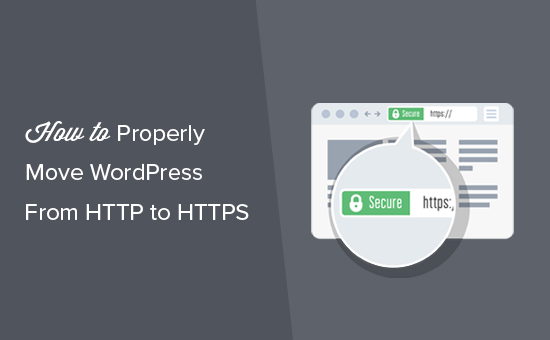
Machen Sie sich keine Sorgen, wenn Sie keine Ahnung haben, was SSL oder HTTPS ist. Auch das werden wir Ihnen erklären.
Was ist HTTPS?
HTTPS oder Secure HTTP ist eine Verschlüsselungsmethode, die die Verbindung zwischen dem Browser des Benutzers und Ihrem Server sichert. Dadurch wird es für Hacker schwieriger, die Verbindung abzuhören.
Jeden Tag geben wir unsere persönlichen Daten an verschiedene Websites weiter, sei es beim Einkaufen oder beim einfachen Einloggen.
Um die Datenübertragung zu schützen, muss eine sichere Verbindung hergestellt werden.
Hier kommen SSL und HTTPS ins Spiel.
Jeder Website wird zur Identifizierung ein eindeutiges SSL-Zertifikat ausgestellt. Wenn ein Server vorgibt, HTTPS zu verwenden, und sein Zertifikat nicht übereinstimmt, warnen die meisten modernen Browser den Benutzer davor, sich mit der Website zu verbinden.
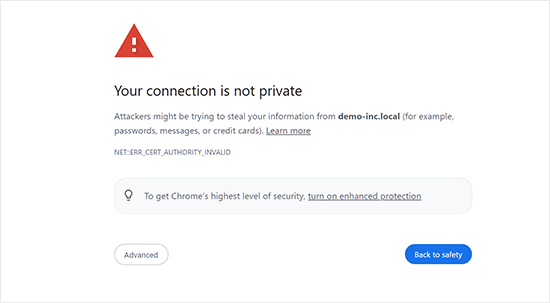
Jetzt werden Sie sich wahrscheinlich fragen, warum ich meine WordPress-Website von HTTP auf HTTPS umstellen muss, vor allem, wenn es sich um einen einfachen Blog oder eine kleine Unternehmenswebsite handelt, die keine Zahlungen entgegennimmt.
Warum brauchen Sie HTTPS und SSL?
Im Jahr 2018 kündigte Google einen Plan zur Verbesserung der allgemeinen Websicherheit an, indem es die Eigentümer von Websites ermutigte, von HTTP auf HTTPS umzusteigen. Als Teil dieses Plans würde der beliebte Chrome-Webbrowser alle Websites ohne SSL-Zertifikat als „nicht sicher“ kennzeichnen.
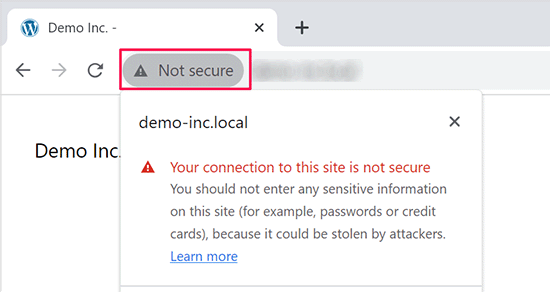
Google sagte auch, dass Websites mit SSL auch Vorteile für die Suchmaschinenoptimierung haben und bessere Suchergebnisse erzielen als unsichere Websites. Seitdem haben viele Websites von HTTP auf HTTPS umgestellt.
Nach der Ankündigung begann Google mit der Einführung der Warnung „Nicht sicher“ in Chrome. Wenn jemand zum Beispiel eine HTTP-Website im Inkognito-Fenster besucht, wird sie als nicht sicher gekennzeichnet. Wenn jemand eine HTTP-Website im normalen Modus besucht und versucht, ein Kontaktformular oder ein anderes Formular auszufüllen, wird die Website als unsicher gekennzeichnet.
Wenn Ihre Leser und Kunden diesen Hinweis sehen, vermittelt er ihnen einen schlechten Eindruck von Ihrem Unternehmen.
Aus diesem Grund müssen alle Websites von HTTP auf HTTPS umstellen und sofort SSL installieren.
Ganz zu schweigen davon, dass Sie SSL benötigen, wenn Sie auf Ihrer eCommerce-Website Online-Zahlungen akzeptieren möchten.
Die meisten Zahlungsunternehmen wie Stripe, PayPal Pro, Authorize.net usw. erfordern eine sichere Verbindung, bevor sie Zahlungen akzeptieren.
Wir verwenden SSL für unsere Websites, einschließlich WPBeginner, OptinMonster, WPForms und MonsterInsights.
Erfordernisse für die Verwendung von HTTPS/SSL auf einer WordPress Website
Die Anforderungen für die Verwendung von SSL in WordPress sind nicht sehr hoch. Sie müssen lediglich ein SSL-Zertifikat erwerben, und vielleicht haben Sie es bereits kostenlos.
Die besten WordPress-Hosting-Unternehmen bieten kostenlose SSL-Zertifikate für alle ihre Nutzer an:
Weitere Einzelheiten finden Sie in unserem Leitfaden zum Erhalt eines kostenlosen SSL-Zertifikats für Ihre WordPress-Website.
Wenn Ihr Hosting-Unternehmen kein kostenloses SSL-Zertifikat anbietet, müssen Sie ein SSL-Zertifikat erwerben.
Wir empfehlen die Verwendung von Domain.com, da sie das beste SSL-Angebot sowohl für reguläre als auch für Wildcard-SSL-Zertifikate anbieten.
Mit dem Kauf eines SSL-Zertifikats erhalten Sie auch ein TrustLogo-Siegel für Ihre Website, und jedes SSL-Zertifikat wird mit einer Sicherheitsgarantie von mindestens 10.000 US-Dollar geliefert. Die Preise beginnen bei 33 $ pro Jahr und die SSL-Zertifikate werden automatisch erneuert.
Sobald Sie ein SSL-Zertifikat erworben haben, müssen Sie Ihren Hosting-Anbieter bitten, es für Sie zu installieren.
Einrichten von WordPress zur Verwendung von SSL und HTTPS
Nachdem Sie ein SSL-Zertifikat für Ihren Domainnamen aktiviert haben, müssen Sie WordPress so einrichten, dass es SSL- und HTTP-Protokolle auf Ihrer Website verwendet.
Wir zeigen Ihnen zwei Methoden, und Sie können diejenige wählen, die Ihren Bedürfnissen am besten entspricht.
Video-Anleitung
Wenn Sie eine schriftliche Anleitung bevorzugen, lesen Sie einfach weiter
Methode 1: Einrichten von SSL/HTTPS in WordPress mithilfe eines Plugins
Diese Methode ist einfacher und wird für Anfänger empfohlen.
Zunächst müssen Sie das Really Simple SSL-Plugin installieren und aktivieren. Weitere Einzelheiten finden Sie in unserer Schritt-für-Schritt-Anleitung zur Installation eines WordPress-Plugins.
Nach der Aktivierung müssen Sie die Seite Einstellungen “ SSL besuchen. Das Plugin wird Ihr SSL-Zertifikat automatisch erkennen und Ihre WordPress Website für die Verwendung von HTTPS einrichten.
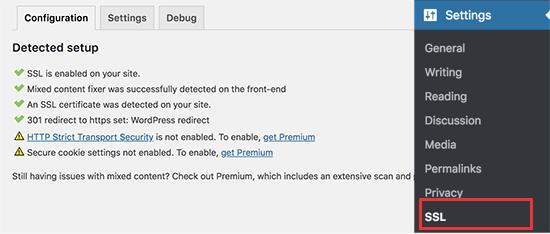
Das Plugin kümmert sich um alles, auch um die Fehler bei gemischten Inhalten. Hier ist, was das Plugin hinter den Kulissen tut:
- SSL-Zertifikat prüfen
- WordPress so einstellen, dass https in URLs verwendet wird
- Umleitungen von HTTP zu HTTPS einrichten
- Suchen Sie nach URLs in Ihrem Inhalt, die noch von unsicheren HTTP-Quellen geladen werden, und versuchen Sie, diese zu korrigieren.
Hinweis: Das Plugin versucht, Fehler bei gemischten Inhalten zu beheben, indem es eine Ausgabepufferungstechnik verwendet. Dies kann sich negativ auf die Leistung auswirken, da es Inhalte auf der Website ersetzt, während die Seite geladen wird. Diese Auswirkung ist nur beim Laden der ersten Seite zu sehen und sollte minimal sein, wenn Sie ein Caching-Plugin verwenden.
Das Plugin sagt zwar, dass Sie SSL beibehalten und das Plugin sicher deaktivieren können, aber das ist nicht zu 100 % wahr. Sie müssen das Plugin immer aktiv lassen, da die Deaktivierung des Plugins zu Fehlern bei gemischten Inhalten führt. Weitere Einzelheiten finden Sie in unserer Really Simple SSL-Bewertung.
Methode 2: Manuelles Einrichten von SSL/HTTPS in WordPress
Diese Methode erfordert eine manuelle Problembehandlung und die Bearbeitung von WordPress-Dateien. Es ist jedoch eine dauerhafte und leistungsoptimierte Lösung, die wir bei WPBeginner verwenden.
Wenn Sie diese Methode für schwierig halten, können Sie einen WordPress-Entwickler beauftragen oder stattdessen die erste Methode anwenden.
Im Rahmen dieser Methode müssen Sie möglicherweise das WordPress-Theme und die Code-Dateien bearbeiten. Wenn Sie dies noch nicht getan haben, lesen Sie unsere Anleitung zum Kopieren und Einfügen von Codeschnipseln in WordPress.
Zuerst müssen Sie die Seite Einstellungen “ Allgemein aufrufen. Hier müssen Sie Ihre WordPress- und Website-URL-Adressfelder aktualisieren, indem Sie http durch https ersetzen.
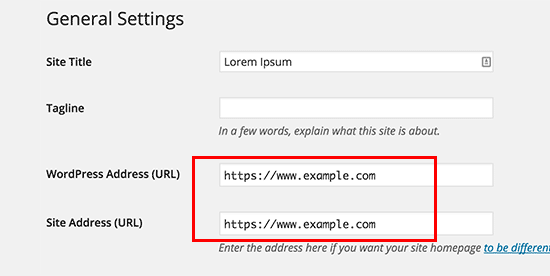
Vergessen Sie nicht, auf die Schaltfläche „Änderungen speichern“ zu klicken, um Ihre Einstellungen zu speichern.
Sobald die Einstellungen gespeichert sind, meldet WordPress Sie ab und Sie werden aufgefordert, sich erneut anzumelden.
Als Nächstes müssen Sie WordPress-Umleitungen von HTTP zu HTTPS einrichten, indem Sie den folgenden Code in Ihre .htaccess-Datei einfügen:
<IfModule mod_rewrite.c>
RewriteEngine On
RewriteCond %{HTTPS} off
RewriteRule ^(.*)$ https://%{HTTP_HOST}%{REQUEST_URI} [L,R=301]
</IfModule>
Wenn Sie mit NGINX-Servern arbeiten, müssen Sie den folgenden Code in Ihrer Konfigurationsdatei hinzufügen, um von HTTP auf HTTPS umzuleiten:
server {
listen 80;
server_name example.com www.example.com;
return 301 https://example.com$request_uri;
}
Vergessen Sie nicht, example.com durch Ihren Domänennamen zu ersetzen.
Wenn Sie diese Schritte befolgen, vermeiden Sie den Fehler „WordPress HTTPS funktioniert nicht“, da WordPress nun Ihre gesamte Website über HTTPS lädt.
Wenn Sie SSL und HTTPS für Ihren WordPress-Administrationsbereich oder Ihre Anmeldeseiten erzwingen möchten, müssen Sie SSL in der Datei wp-config.php konfigurieren.
Fügen Sie den folgenden Code oberhalb der Zeile „That’s all, stop editing!“ in Ihre wp-config.php-Datei ein:
define('FORCE_SSL_ADMIN', true);
Diese Zeile ermöglicht es WordPress, SSL / HTTPs im WordPress-Administrationsbereich zu erzwingen. Sie funktioniert auch bei WordPress-Multisite-Netzwerken.
Sobald Sie dies getan haben, ist Ihre Website vollständig für die Verwendung von SSL/HTTPS eingerichtet, aber Sie werden immer noch Fehler bei gemischten Inhalten feststellen.
Diese Fehler werden durch Quellen (Bilder, Skripte oder Stylesheets) verursacht, die noch über das unsichere HTTP-Protokoll in den URLs geladen werden. Wenn dies der Fall ist, können Sie in der Adressleiste Ihrer Website kein sicheres Vorhängeschloss-Symbol sehen.

Viele moderne Browser blockieren automatisch unsichere Skripte und Ressourcen.
Möglicherweise sehen Sie in der Adressleiste Ihres Browsers ein Vorhängeschloss-Symbol mit einem entsprechenden Hinweis.
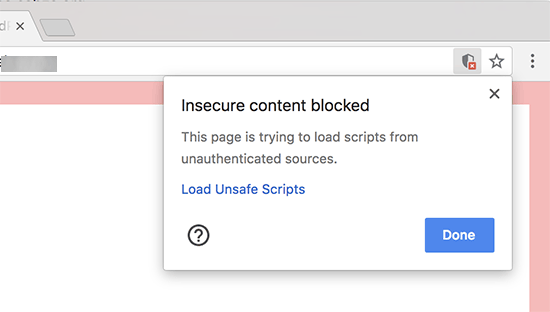
Mit dem Tool Inspect können Sie herausfinden, welche Inhalte über ein unsicheres Protokoll bereitgestellt werden.
Der Fehler bei gemischten Inhalten wird als Warnung in der Konsole angezeigt, mit Details für jedes Element mit gemischten Inhalten.

Sie werden feststellen, dass die meisten URLs Bilder, Iframes und Galerien sind, während einige Skripte und Stylesheets sind, die von Ihren WordPress Plugins und Themes geladen werden.
Reparieren von gemischten Inhalten in der WordPress-Datenbank
Bei den meisten falschen URLs handelt es sich um Bilder, Dateien, Einbettungen und andere Daten, die in Ihrer WordPress-Datenbank gespeichert sind. Lassen Sie uns diese zuerst beheben.
Sie müssen alle Erwähnungen Ihrer alten URL in der Datenbank finden, die mit http beginnen, und sie durch Ihre neue URL ersetzen, die mit https beginnt.
Sie können dies ganz einfach tun, indem Sie das Plugin “ Search & Replace Everything “ installieren und aktivieren. Weitere Details finden Sie in unserer Schritt-für-Schritt-Anleitung für die Installation eines WordPress Plugins.
Nach der Aktivierung müssen Sie die Seite Werkzeuge “ WP Search & Replace besuchen. Unter dem Feld „Suchen“ müssen Sie die URL Ihrer Website mit http eingeben. Danach fügen Sie unter dem Feld „Ersetzen“ die URL Ihrer Website mit https hinzu.

Darunter sehen Sie alle Ihre WordPress-Datenbanktabellen. Sie müssen alle auswählen, um eine gründliche Prüfung durchzuführen.

Klicken Sie dann auf den Button „Vorschau Suchen & Ersetzen“, um alle Änderungen zu sehen, die das Plugin vornehmen wird. Klicken Sie abschließend auf den Button „Alle ersetzen“.
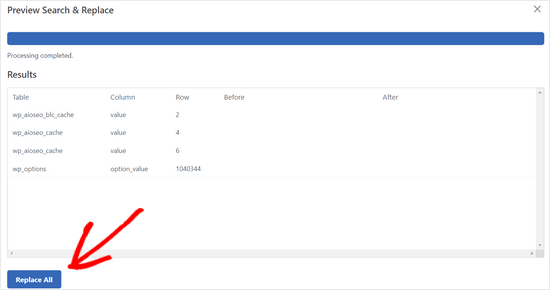
Das Plugin durchsucht nun Ihre WordPress-Datenbank nach den URLs, die mit http beginnen, und ersetzt sie durch sichere https-URLs. Je nach Größe Ihrer WordPress-Datenbank kann dies eine Weile dauern.
Fehler bei gemischten Inhalten im WordPress-Theme beheben
Ein weiterer häufiger Grund für Fehler bei gemischten Inhalten ist Ihr WordPress-Theme. Jedes anständige WordPress-Theme, das den WordPress-Codierungsstandards entspricht, wird dieses Problem nicht verursachen.
Zunächst müssen Sie das Inspektionstool Ihres Browsers verwenden, um die Ressourcen zu finden und festzustellen, von wo sie geladen werden.

Danach müssen Sie sie in Ihrem WordPress-Theme finden und durch https ersetzen. Dies wird für die meisten Anfänger etwas schwierig sein, da Sie nicht sehen können, welche Theme-Dateien diese URLs enthalten.
Behebung von Fehlern bei gemischten Inhalten, die durch Plugins verursacht werden
Einige Mixed-Content-Ressourcen werden von WordPress-Plugins geladen. Jedes WordPress-Plugin, das die WordPress-Codierungsstandards einhält, verursacht keine Mixed-Content-Fehler.
Wir raten davon ab, WordPress Plugins zu bearbeiten. Stattdessen sollten Sie den Autor des Plugins kontaktieren und ihm Bescheid geben. Wenn dieser nicht antwortet oder nicht in der Lage ist, das Problem zu beheben, sollten Sie eine geeignete Alternative finden.
Hinweis: Wenn aus irgendeinem Grund immer noch ein Fehler bei gemischten Inhalten auftritt, empfehlen wir die vorübergehende Verwendung des Really Simple SSL Plugins, damit Ihre Benutzer nicht beeinträchtigt werden, während Sie das Problem auf einer Staging-Website beheben oder einen Entwickler beauftragen.
Melden Sie Ihre HTTPS-Website bei Google Search Console an
Suchmaschinen wie Google betrachten https und http als zwei unterschiedliche Websites. Um SEO-Probleme zu vermeiden, müssen Sie Google mitteilen, dass Ihre Website umgezogen ist.
Dazu müssen Sie nur in Ihr Google Search Console Konto gehen und auf den Button „Add a Property“ klicken.

Daraufhin wird ein Popup-Fenster angezeigt, in dem Sie die neue https-Adresse Ihrer Website eingeben müssen.
Es gibt zwei Methoden zur Überprüfung von Websites: Domänenname oder URL-Präfix. Wir empfehlen die Methode mit dem URL-Präfix, weil sie flexibler ist.
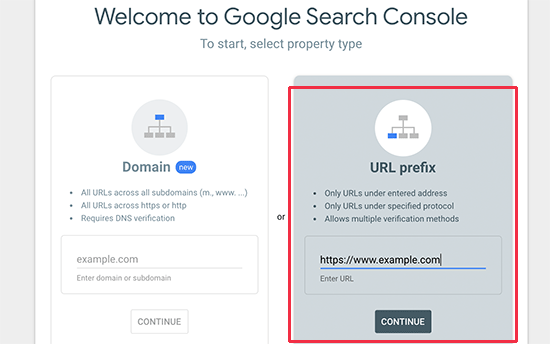
Danach werden Sie von Google aufgefordert, die Eigentumsrechte an Ihrer Website zu bestätigen.
Es gibt mehrere Möglichkeiten, dies zu tun. Wählen Sie eine Methode aus, und Sie erhalten Anweisungen zur Überprüfung Ihrer Website. Wir empfehlen die Verwendung der HTML-Tag-Methode.
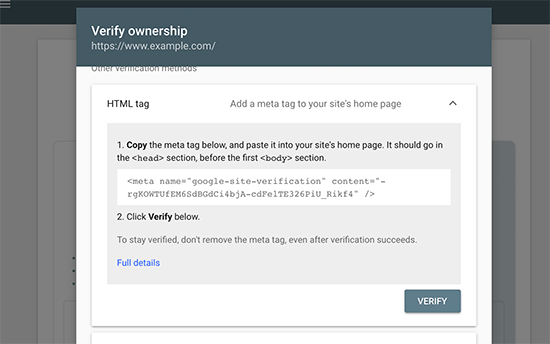
Sie sehen nun ein HTML-Code-Snippet, das Sie in den Head-Abschnitt Ihrer WordPress-Website einfügen müssen.
Search Console-Verifizierungscode mit All in One SEO hinzufügen
Installieren und aktivieren Sie zunächst das All in One SEO for WordPress-Plugin. Weitere Einzelheiten finden Sie in unserer Anleitung zur Installation eines WordPress-Plugins.
Hinweis: Es gibt auch eine kostenlose Version von All in One SEO, die Sie ausprobieren können.
Gehen Sie nach der Aktivierung auf die Seite All in One SEO “ Allgemeine Einstellungen und klicken Sie auf Google Search Console.

Darunter müssen Sie den Verifizierungscode hinzufügen, den Sie zuvor von der Google Search Console-Website kopiert haben.
Vergessen Sie nicht, auf den Button „Änderungen speichern“ zu klicken, um Ihre Einstellungen zu speichern.
Wechseln Sie dann wieder zum Tab Google Search Console und klicken Sie auf den Button „Überprüfen“.

Sobald Ihre Website verifiziert ist, zeigt Google hier Ihre Search Console-Berichte an.
Sie müssen auch sicherstellen, dass sowohl die https- als auch die http-Version zu Ihrer Search Console hinzugefügt werden.
Damit teilen Sie Google mit, dass die https-Version Ihrer Website als die Hauptversion behandelt werden soll. In Kombination mit den 301-Weiterleitungen, die Sie zuvor eingerichtet haben, wird Google Ihre Suchrankings auf die https-Version Ihrer Website übertragen, und Sie werden höchstwahrscheinlich Verbesserungen bei Ihren Suchrankings feststellen.
Wir hoffen, dass dieser Artikel Ihnen geholfen hat, HTTPS und SSL in WordPress hinzuzufügen. Vielleicht interessieren Sie sich auch für unseren ultimativen WordPress-Sicherheitsleitfaden mit Schritt-für-Schritt-Anleitungen, um Ihre WordPress-Website sicher zu halten, oder für unsere Expertenauswahl der besten Analyselösungen für WordPress.
Wenn Ihnen dieser Artikel gefallen hat, dann abonnieren Sie bitte unseren YouTube-Kanal für WordPress-Videotutorials. Sie können uns auch auf Twitter und Facebook finden.




Syed Balkhi says
Hey WPBeginner readers,
Did you know you can win exciting prizes by commenting on WPBeginner?
Every month, our top blog commenters will win HUGE rewards, including premium WordPress plugin licenses and cash prizes.
You can get more details about the contest from here.
Start sharing your thoughts below to stand a chance to win!
Mrteesurez says
This is really fantastic.
Notinhy is bad as a visitors seeing a website insecured especially an ecommerce that collect online payment from users, this is definitely a bad experience.
That’s why it’s always advisable to have https Website. Choosing one of the hostings you have listed like Bluehost and others gives free SSL and free domain for the first year.
With Bluehost, you don’t need to manually installed the SSL certificate on your website.
Thanks, sharing this.
Moinuddin Waheed says
one of my clients recently purchased a shared hosting from GoDaddy and then asked to make his website.
I started making one and realised that it doesn’t come with inbuilt one click SSL installation like that of hostinger, bluehost and other hosting services providers mentioned above.
The value of having good hosting was evident when I had to go through the painstaking process of getting SSL certificate installed.
it is very advisable that one must choose good hosting service.
Moinuddin Waheed says
Having https for websites is a must for securing the trust of the visitors on the website.
just curious if we have already enabled SSL for our websites, is it necessary to change everywhere from http to https?
or it will automatically take one.
WPBeginner Support says
It would depend on how you enabled SSL and your hosting provider as some will automatically update your site to https while others wont. You would want to check your site to see if it was updated and if not you would need to manually update the site address.
Admin
Jiří Vaněk says
It is usually necessary to manually change everything to https or use the really simple SSL plugin. If part of the site will be http and part will be https, it is called mixed content and will end up with error and problems.
THANKGOD JONATHAN says
If you are beginner and do not know much about coding I recommend you use the first method.
editing your WordPress code is very risky much especially for no coders. After all, the plugin is easier to use and it also have a free version.
Moinuddin Waheed says
Most of the hosting providers now a days give free ssl certificate to your site with a one click install as you have mentioned there.
having ssl certificate installed on website is of utmost importance as it gives a sense of security to the visitors and they can be sure about every thing they do on SSL certificate installed website is secure .
thank you for making a detailed description about http and https.
WPBeginner Support says
You’re welcome
Admin
Nimdaqiu says
I feel like I am no more a beginner now. Thank you for this beautifully detailed article.
WPBeginner Support says
Glad we could help make the process simpler!
Admin
Andrew Meador says
I followed Method 2. The only thing I modified was using the WordPress redirect method. My web host has a tool that creates a redirect (for Windows Server hosting) which adds redirect rules into the web.config – allowing the redirect to HTTPS to happen at the web server level vs at the WordPress level. Works good and is 1 level of abstraction higher. Thanks!
WPBeginner Support says
Thanks for sharing, not all hosting providers offer that but glad your host was able to help
Admin
Clinton Waller says
Thank you very much for this excellent tutorial.
I recently installed an SSL cert and was dreading the change-over with WordPress and Google. Not saying there wasn’t any pain, but your step-by-step instructions helped immensely!
Really appreciated the .htaccess code too, that’s just perfect. I was worried that Google would index both the insecure http and secure https variants of the old vs new website and give me a ranking penalty, but that trick completely avoids serving up insecure legacy http content — a real plus!
William says
I have a mix of domains (all HTTPS) on my WordPress site. Can this plugin go through my site and set them all to my current domain?
WPBeginner Support says
You would want to check with your hosting provider as some have tools for what it sounds like you are wanting to do.
Admin
Long says
There are just no ‚Wordpress Address‘ and ‚Site Address‘ in ‚General Settings‘.
Now I use wordpress multisite, one site is https and another is http. This wordpress installation is new, I have already set https at the previous wordpress installation in my sitegroud.
WPBeginner Support says
You would need to go to the network admin to change the URLs of your sites on a multisite installation.
Admin
NIKHIL says
I am Using the First Method So Is There Any Need to Make Changes in WordPress and Site Address URL ??
WPBeginner Support says
So long as there are no hiccups with the plugin you shouldn’t need to edit your address and URL as the plugin would handle that for you.
Admin
Stein says
I followed the steps in method 2, but once I reached the step „Once the settings are saved, WordPress will log you out, and you will be asked to re-login.“ instead of just logging me out it also now says that „this site is not avalible“ when I try to log in to wp-admin again, making the next steps impossible to do.
So how can I access the wp-admin site following the url change?
WPBeginner Support says
For that specific error, you would want to go through the troubleshooting steps in our article below:
https://www.wpbeginner.com/beginners-guide/beginners-guide-to-troubleshooting-wordpress-errors-step-by-step/
Admin
Jithin says
after adding this home page is redirecting but posts not redirecting to https.
http and https .. both are working .. please help.
WPBeginner Support says
Should you run into that issue, you would want to reach out to your hosting provider to ensure they do not have any redirects set up.
Admin
shantun says
It helps a lot thank you
WPBeginner Support says
Glad our guide was helpful
Admin
RichPat says
Thank you for the SSL upgrade instructions.
Using Really Simple SSL with my hosting provided certificate was a v simple upgrade process
WPBeginner Support says
Glad our guide was helpful
Admin
Michael says
Thanks for your valuable content.please I want to ask,if I can use the Really simple SSL plugin which is easier,why will I want to do it manually.
WPBeginner Support says
That would be mainly for personal preference, there shouldn’t be a major difference between using the plugin or manually changing it.
Admin
Jithin says
Thank you for the guide.
I going to install a fresh WordPress on hostgator. Do I need to do anything different for the HTTPS ? or follow the guide after installation ?
WPBeginner Support says
You can follow our guide after installing your site for enabling https.
Admin
nick Devine says
Hello, I went into settings and changes http to https and now I am locked out of wordpress completely. Do you have a solution to this as it is a clients website and I am concerned I have lost everything completely. Nick
WPBeginner Support says
You would want to enable an SSL certificate for the site or reach out to your hosting provider to assist you in setting the URLs back to HTTP
Admin
Oleksandr Piddubnyy says
First, you need to visit Settings » General page. From here you need to update your WordPress and site URL address fields by replacing http with https.
BUT! After that my page is totally disabled! I can’t backup. I can’t even enter to the admin panel. And I don’t know what’s going on. What should I do? Do you have any idea?
WPBeginner Support says
It sounds like you may have not enabled an SSL certificate on your site before changing the address. You would want to reach out to your hosting provider to enable an SSL certificate for your site or have them change your URLs back to HTTP
Admin
osama khan says
Good day, thank you for the guide. I installed a fresh wordpress on a VPS with an ip addresss. Now, I want to change it to a domain name – Do I need to do anything different for the HTTPS:// ?
WPBeginner Support says
You would want to check with your hosting provider for how their servers are set up for swapping to the domain.
Admin
Araceli says
Hi! So it looks like, after following the steps through „Fixing Mixed Content Errors in WordPress Theme,“ I see that my images are causing mixed content issues. The error I am getting is, „This content should also be served over HTTPS.“ How can I fix this?
WPBeginner Support says
For fixing the mixed content you would want to take a look at our article below:
https://www.wpbeginner.com/plugins/how-to-fix-the-mixed-content-error-in-wordpress-step-by-step/
Admin
Araceli says
Will do…thank you!
Putri says
would it be okay if I change website address and site address to https but didn’t do the rest of manual process, then install the plugin instead?
WPBeginner Support says
We would recommend if you are planning on using the plugin to start with the plugin method to prevent any hiccups during the process.
Admin
Amar says
Hello Sir,
I have wordpress site running on wordpress 3.5.1 . can I use really simple ssl plugin for it. The plugin says it needs wordpress 4.6 and higher.
Pls suggest me how can i do it
Thanks
WPBeginner Support says
For updating your WordPress site, you would want to follow our guide below:
https://www.wpbeginner.com/beginners-guide/ultimate-guide-to-upgrade-wordpress-for-beginners-infograph/
Admin
Shawn says
I am unable to access the admin login URL after updating the site URLs, it keep redirecting to https but I get a „This site can not be reached error“ .. I also tried to update the .htaccess file but no luck. the original website is also not getting redirected to https.
Any ides what might I be missing here?
WPBeginner Support says
You would want to first reach out to your hosting provider for them to take a look and ensure your SSL certificate doesn’t have an issue.
Admin
Lola says
Thank you!
Thank you!
THANK YOU!!!
WPBeginner Support says
You’re welcome
Admin
Kevin says
Thank you, that Plug in Better Search and Replace made the trick!
WPBeginner Support says
You’re welcome, glad our recommendation was helpful
Admin
daniel says
where exactly should I place the code in the .htaccess file?
WPBeginner Support says
The normal location would be beneath the current code in your htaccess file
Admin
Jessica says
Inner pages and post pages are still opening with http also, which will impact on search engines. What should I do now ?
WPBeginner Support says
You would likely need to clear all caching on your site and you may want to check with your hosting provider that the SSL certificate was applied correctly.
Admin
Leos says
Why would you add define(‚FORCE_SSL_ADMIN‘, true) to wp-config file if the .htaccess redirect rule already does the job?
When adding the line to wp-config file I got a syntax error right after and it was not possible to get to the admin area.
WPBeginner Support says
The FORCE_SSL_ADMIN is for your admin area to ensure it is using HTTPS. You would want to ensure you copied the entire code correctly. If you were missing the ; it would give a syntax error.
Admin
rohan says
Hello,
Thanks for the detailed guide. After switching from HTTP to HTTPS, I added the new property to Google Search Console.
Do I need to submit the sitemaps again as well on the HTTPS version in GSC?
Beginner query.
WPBeginner Support says
You would want to do that for safety, yes
Admin
Celena says
Thank you! Very helpful!
WPBeginner Support says
You’re welcome
Admin
Phil says
Better Search & replace is 1.3.3 and has not been updated for a year and is not tested on the current wordpress version. It is compatible only up to 5.2.6.
Is it safe to use, or can you recommend an alternative please?
WPBeginner Support says
For those warnings, you would want to take a look at our guide below.
https://www.wpbeginner.com/opinion/should-you-install-plugins-not-tested-with-your-wordpress-version/
Admin
RomRom says
Solution 2 wasn’t working for me, the website would be unavaible.
After a few attemps, I noticed my hosting provider already provides a force https option. Turn it on, and bingo.
WPBeginner Support says
Glad you were able to find a solution that worked for you
Admin
Feranmi says
What of if my hosting provider doesn’t support free SSL certificate can the plugin works also or how can I get it for free?
WPBeginner Support says
If your current host does not offer free SSL then you would want to reach out to them for what options are available.
Admin
Yasir says
Is this plugin is secured.
WPBeginner Support says
Yes, the plugin should currently be secured.
Admin
ammar says
Hi, if i’m using the 1st method, do I need to follow the Submit my HTTPS Site to Google Search Console step also after that?
TQ
WPBeginner Support says
Yes, you would still want to follow that step
Admin
Swen says
I installed the Really Simple SSL plugin, which states that you should manually replace every http:// in all .css and .js files to //. That doesn’t sound really simple to me. As a beginner I set up a simple website with a couple of pictures. Is it common that http:// statements are in these files?
WPBeginner Support says
Normally those links are not common so it shouldn’t be something to worry about.
Admin
Lucas says
Hi,
When adding the code to .htaccess, i get a „too many redirects“ error. I tryed adding to the existing code above, below, and also erasing the existing code and using only the new. All three option get too many redirects.
Is there something I should change there? Thanks in advance for your help!
WPBeginner Support says
You would want to try some of the suggestions in our article here:
https://www.wpbeginner.com/wp-tutorials/how-to-fix-error-too-many-redirects-issue-in-wordpress/
for resolving the too many redirects and should those recommendations not work, you would want to check with your hosting provider to ensure they do not have a system that needs to be modified to point to the https version of your site.
Admin
Sotir Sotirov says
I’ve tried using the plugin but when I do the website becomes not accessible. I’ve tried the manual approach but once I’ve changed the addresses in WP settings the site becomes not accessible again.
WPBeginner Support says
You would want to reach out to your hosting provider to ensure that your SSL certificate is connected to your domain correctly and they should be able to help
Admin
Mike Ashworth says
I am about to make the change to SSL and will be following the guidance in te article, initially using the really simple ssl plugin. Before i begin i have a quick question.
If I use the really simple ssl plugin, which takes care of everything, i can leave the general settings in wordpress for wordpress address and site address as http rather than change to https as the plugin will be taking care of it?
WPBeginner Support says
Correct
Admin
Mike Ashworth says
Thanks for confirming. I have one other rquestion.
having just activated lets encrypt ssl on siteground for a website, i am asked wther i want to switch the following on or leave it off.
HTTPS Enforce – Forces your site to work entirely over an encrypted HTTPS connection. The redirect is performed on server level and works for any website.
Do i leave this off as the really simple ssl plugin will take care of this as well?
WPBeginner Support says
Yes, you can leave that off, you would only want to use that should there be any issues with the plugin or Google finding http links
Mike Ashworth says
Thanks for your advice. WP Beginner is such an awesome website. Keep up the great work!
stephan says
I want to thank you a lot. I have been looking for the errors over 12hours and get it done with better replace plugins. Thanks a lot dear.
WPBeginner Support says
Glad our recommendation could help you
Admin
Arlina says
Does adding in the plugin of SSL slow down my blog speed performance?
WPBeginner Support says
It shouldn’t slow your site down
Admin
Peter Wilson says
Can someone tell me, do I replace the contents on my.htaccess. file with the suggested code or do I place it and the beginning/end of the eisting entry.
WPBeginner Support says
You would add it at the end of the current code in your htaccess file.
Admin
Peter Wilson says
Thanks for the quick reply. So, would that be after the existing and before the # END WordPress, or does it go after the .
WPBeginner Support says
That should not matter, it may be a good idea to do it after should you need to remove the code in the future
Shivanandana says
Really awesome guide. Thank you so much! Thanks again for this detailed post!
WPBeginner Support says
Glad you like our content
Admin
Håkan says
Great content, helped me alot!
WPBeginner Support says
Thank you, glad our content was helpful
Admin
Harsha says
Very useful guide, thank you very much!
WPBeginner Support says
You’re welcome, glad our article was helpful
Admin
Jan-Peter Molenaar says
Thanks a lot!! Valuable content
WPBeginner Support says
You’re welcome, glad our content is helpful
Admin
Greg says
This article was so helpful. Thank you so much! Made it very easy.
WPBeginner Support says
You’re welcome, glad our article was helpful
Admin
Nel says
Most helpful guide ever. Thank you for this.
WPBeginner Support says
You’re welcome
Admin
Jessica Quadra says
This was so helpful and each step worked perfectly. Thank you!!
WPBeginner Support says
You’re welcome, glad our guide could help
Admin